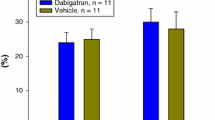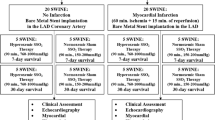Summary
Oxygen-derived free radicals (O −2 and ·OH) have been implicated in myocardial injury associated with coronary artery occlusion followed by reperfusion. While these cytotoxic oxygen species are predominantly produced upon reintroduction of molecular oxygen to previously ischemic tissue, they may also be generatedthroughout coronary occlusion in species (such, as dog and man) in which native collateral vessels permit residual blood flow into the ischemic bed. To test this theory, 20 anesthetized, open-chest dogs underwent 6 h of permanent left anterior descending coronary artery occlusion: ten dogs were treated with the potent free radical scavenging enzymes superoxide dismutase (SOD: 5 mg/kg per hour) plus catalase (5 mg/kg per hour), while the remaining ten animals received saline. Infusion of drug or saline solution was begun 15 min prior to occlusion, and maintained throughout occlusion. Infusion of SOD+catalase did not significantly affect the extent of the area at risk of infarction (19.5±1.8% vs 24.0±1.4% of the left ventricle for the treated vs control group;P=NS), did not reduce myocardial oxygen demand (heart rate and arterial pressures were comparable for both groups), and did not alter collateral blood flow to the ischemic myocardium. However, mean infarct size in dogs treated with SOD+catalase (39.6±6.6% of the area at risk; 8.4±2.1% of the left ventricle) was significantly smaller than that observed in the saline controls (73.0±6.3% of the area at risk,P<0.01; 19.8±2.2% of the left ventricle,P<0.01). Thus, infusion of SOD+catalase prior to and during 6 h of coronary occlusion significantly reduced infarct size assessed at 6 h postocclusion. To determine whether this reduction in infarct size represented long-term salvage of ischemic myocardium, an additional 14 dogs (seven treated and seven controls) underwent the same procedure as described above; in this case the artery was reperfused after the 6-hour occlusion period, infusion of the SOD+catalase or saline solution stopped at 5–10 min postreperfusion, and the hearts examined at 30–48 h postocclusion. In contrast to the results at 6 h postocclusion, the necrosis at 30–48 h postocclusion was large, confluent and transmural in all dogs (infarct size=21.2±2.5% vs 22.7±4.4% of the left ventricle for treated vs controls;P=NS). These results suggest that infusion of SOD+catalase in this model may delay, but not prevent, the development of ischemic necrosis.
Similar content being viewed by others
References
Akizuki S, Yoshida S, Chambers DE, Eddy LJ, Parmley LF, Yellon DM, Downey JM (1985) Infarct size limitation by the xanthine oxidase inhibitor allopurinol in closed-chest dogs with small infarcts. Cardiovasc Res 19:686–692
Ambrosio G, Becker LC, Hutchins GM, Weisfeldt ML (1985) Reduction in experimental infarct size by recombinant human superoxide dismutase administration during reperfusion. Circulation 72:III-351 (abstr)
Burton KP, McCord JM, Ghai G (1984) Myocardial alterations due to free radical generation. Am J Physiol 246:H776-H783
Burton KP (1985) Superoxide dismutase enhances recovery following myocardial ischemia. Am J Physiol 248:H637-H643
Casale AS, Bulkley GB, Bulkley BH, Flaherty JT, Gott VL, Gardner TJ (1983) Oxygen free radical scavengers protect the arrested, globally ischemic heart upon reperfusion. Surg Forum 34:313–316
Chambers DE, Parks DA, Patterson G, Roy R, McCord JM, Yoshida S, Parmley LF, Downey JM (1985) Xanthine oxidase as a source of free radical damage in myocardial ischemia. J Mol Cell Cardiol 17:145–152
Domenech RJ, Hoffman JE, Noble MM, Saunders KB, Henson RJ, Subyanto S (1969) Total and regional coronary flow measured by radioactive microspheres in conscious and anesthetized dogs. Circ Res 25:581–596
Ferrari R, Ceconi C, Cuvello S, Guarnieri C, Calderera CM, Albertini A, Visioli O (1985) Oxygenmediated myocardial damage during ischemia and reperfusion: role of the cellular defenses against oxygen toxicity. J Mol Cell Cardiol 17:937–945
Fishbein MC, Meerbaum S, Rit J, Lando U, Kanmatsuse K, Mercier JC, Corday E, Ganz W (1981) Early phase acute myocardial infarct size quantification: validation of the triphenyltetrazolium chloride tissue enzyme staining technique. Am Heart J 101:593–600
Fridovich I (1978) The biology of oxygen radicals. Science 201:875–880
Gallagher KP, Buda AJ, Pace D, Gerren RA, Schlafer M (1986) Failure of superoxide dismutase and catalase to alter infarct size in conscious dogs after 3 hours of occlusion followed by reperfusion. Circulation 73:1065–1076
Gardner TJ, Stewart JR, Casale AS, Downey JM, Chambers DE (1983) Reduction of myocardial ischemic injury with oxygen-derived free radical scavengers. Surgery 94:423–437
Guaduell Y, Duvelleroy MA (1984) Role ofoxygen radicals in cardiac injury due to reoxygenation. J Mol Cell Cardiol 16:459–470
Guarnieri C, Flamingi F, Caldarera CM (1980) Role of oxygen in the cellular damage induced by reoxygenation of hypoxic heart. J Mol Cell Cardiol 12:797–808
Hammond B, Kontos HA, Hess ML (1985) Oxygen radicals in adult respiratory distress syndrome, in myocardial ischemia and reperfusion injury, and in cerebral vascular damage. Can J Physiol Pharmacol 63:173–187
Hofmann M, Hofmann M, Genth K, Schaper W (1983) The influence of reperfusion on infarct siz after experimental coronary artery occlusion. Basic Res Cardiol 75:572–582
Jolly SR, Kane WJ, Bailie MB, Abrams GD, Lucchesi BR (1984) Canine myocardial reperfusion injury: its reduction by the combined administration of superoxide dismutase and catalase. Circ Res 54:277–285
McCord JM (1984) Are free radicals a major culprit? In: Hearse DJ, Yellon DM (eds) Therapeutic Approaches to Myocardial Infarct Size Reduction Raven Press, New York, pp 209–218
Myers ML, Bolli R, Lekich RF, Hartley CJ, Roberts R (1985) Enhancement of recovery of myocardial function by oxygen free-radical scavengers after reversible regional ischemia. Circulation 72:915–921
Parks DA, Bulkley GB, Granger DN, Hamilton SR, McCord JM (1982) Ischemic injury in the cat small intestine: role of superoxide radicals. Gastroenterology 82:9–15
Przyklenk K, Kloner RA (1986) Superoxide dismutase plus catalase improve contractile function in the canine model of the “stunned myocardium” Circ Res 58:148–156
Reimer KA, Jennings RB (1979) The “wavefront phenomenon” of myocardial ischemic cell death. II. Transmural progression of necrosis within the framework of ischemic bed size (myocardium at riks) and collateral flow. Lab Invest 40:633–644
Reimer KA, Jennings RB (1985) Failure of xanthine oxidase inhibitor allopurinol to limit infarct size after ischemia and reperfusion in dogs. Circulation 71:1069–1075
Romson JL, Hook BG, Kunkel SL, Abrams GD, Schork A, Lucchesi BR (1983) Reduction of the extent of ischemic myocardial injury by neutrophil depletion in the dog. Circulation 67:1016–1023
Schaper W, Frenzel H, Hort W (1979) Experimental coronary artery occlusion: I. Measurement of infarct size. Basic Res Cardiol 74:46–53
Schlafer M, Kane PF, Kirsch MM (1982) Superoxide dismutase plus catalase enhanced the efficacy of hypothermic cardioplegia to protect the globally ischemic, reperfused heart. J Thorac Cardiovasc Surg 83:830–839
schlafer M, Kane PF, Wiggins VY, Kirsch MM (1982) Possible role for cytotoxic oxygen metabolites in the pathogenesis of cardiac ischemic injury. Circulation 66 (Suppl I):85–92
Stewart JR, Blackwell WH, Crute SL, Loughlin V, Hess ML, Greenfield LJ (1982) Prevention of myocardial ischemic reperfusion injury with oxygen free radical scavengers. Surg Forum 33:317–320
Uraizee A, Reimer KA, Murray CE, Jennings RB (1986) Failure of superoxide dismutase to limit myocardial infarct size in a canine ischemia/reperfusion model. Circulation 74:II372 (abstr)
Vivaldi MT, Kloner RA, Schoen FJ (1985) Triphenyltetrazolium staining of irreversible ischemic injury following coronary artery occlusion in rats. Am J Pathol 121:522–530
Werns SW, Shea MJ, Driscoll EM, Cohen C, Abrams GD, Pitt B, Lucchesi BR (1986) The independent effects of oxygen radical scavengers on canine infarct size: reduction by superoxide dismutase but not catalase. Circ Res 56:895–898
Werns SW, Shea MJ, Mitsos SE, Dysko RC, Fatone JC, Shork MA, Abrams GD, Pitt B, Lucchesi BR (1986) Reduction of the size of infarction by allopurinol in the ischemic-reperfused canine heart. Circulation 73:518–524
Zweier JL, Flaherty JT, Weisfeldt ML (1985) Observation of free radical generation in the post-ischemic heart. Circulation 72:III-350 (abstr)
Author information
Authors and Affiliations
Additional information
Performed during Dr. Kloner's tenure as an Established Investigator of the American Heart Association.
Rights and permissions
About this article
Cite this article
Przyklenk, K., Kloner, R.A. Effect of oxygen-derived free radical scavengers on infarct size following six hours of permanent coronary artery occlusion: salvage or delay of myocyte necrosis?. Basic Res Cardiol 82, 146–158 (1987). https://doi.org/10.1007/BF01907062
Received:
Issue Date:
DOI: https://doi.org/10.1007/BF01907062




